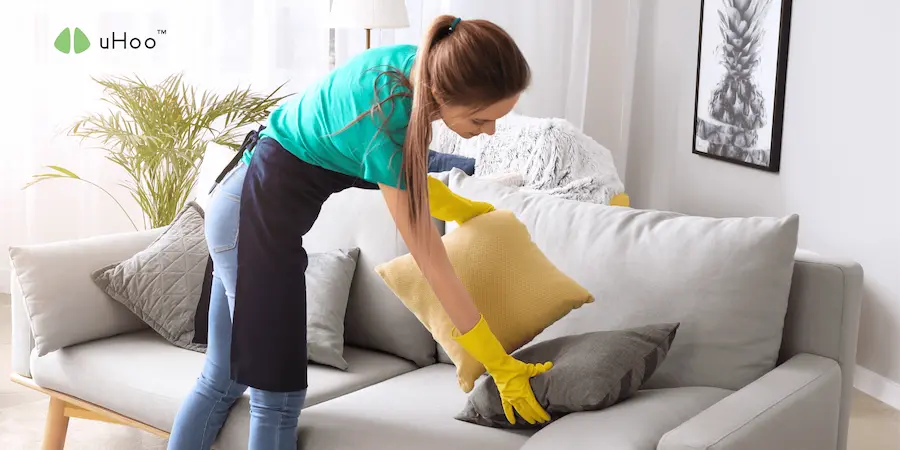Your upholstered furniture – sofas, armchairs, headboards – provides comfort and style, but it also silently collects dust, spills, and the remnants of daily life. While regular vacuuming and quick spot treatments are essential, tackling truly stubborn issues requires advanced techniques to bring your beloved pieces back to their former glory. Here are 10 expert tips to rescue your upholstery and achieve a like-new finish, even when facing the most challenging problems.
Tip #1: The Upholstery Code Whisperer
Before you unleash any cleaning solutions, become a code whisperer. Check the manufacturer’s tag, usually located under cushions or on the bottom. These codes (W, S, WS, X) dictate which cleaning methods are safe for your specific fabric. Ignoring this code can lead to irreversible damage. “W” means water-based cleaners are safe, “S” requires solvent-based cleaners, “WS” allows for either, and “X” signifies professional cleaning only.
Tip #2: The Multi-Step Stain Slayer
Stubborn stains often require a multi-pronged attack. Start by gently blotting (never rubbing!) the area to remove any excess liquid. Then, apply a pre-treatment solution appropriate for the stain type (enzyme cleaner for organic stains, specialized upholstery cleaner for others). Allow it to dwell according to the product instructions before proceeding with a deeper cleaning method.
Tip #3: The Steam Scene for Deep Dirt and Refreshing
For fabrics coded “W” or “WS,” a gentle steam cleaner can work wonders for deep-seated dirt and overall revitalization. The steam helps to loosen embedded grime, which can then be extracted. Use the upholstery attachment and move slowly and evenly. Be cautious not to oversaturate the fabric.
Expert Tip: Follow up with a dry cloth to absorb excess moisture.
Tip #4: The Solvent Savvy Solution for “S” Codes
For “S” coded fabrics, water-based cleaners are a no-go. Invest in a quality solvent-based upholstery cleaner specifically designed for these materials. Work in a well-ventilated area and follow the product instructions meticulously. Test in an inconspicuous spot first to ensure colorfastness.
Tip #5: The Baking Soda and Vinegar Power Duo
This dynamic duo can tackle a surprising range of issues. For odors, sprinkle baking soda liberally over the upholstery, let it sit for several hours (or even overnight), and then vacuum thoroughly. For some stains (test first!), a diluted white vinegar solution (1 part vinegar to 2 parts water) applied with a cloth and then blotted can be effective.
Tip #6: The Ice Cold Extraction for Sticky Situations
For sticky culprits like gum or hardened wax, try freezing them with an ice cube in a plastic bag. Once frozen solid, they become brittle and easier to carefully chip away with a dull knife or spatula. Vacuum up any residue and then treat any remaining stain with an appropriate cleaner.
Tip #7: The Professional Polish for Unyielding Problems
Sometimes, despite your best efforts, a stain or deep-seated issue proves too challenging. Don’t hesitate to call in professional upholstery cleaners. They possess specialized equipment, industrial-strength cleaning solutions, and the expertise to handle even the most stubborn upholstery woes without causing damage.
Tip #8: The Gentle Enzyme Action for Organic Messes
Pet accidents, blood, and other organic stains require enzymatic cleaners. These contain enzymes that break down the organic compounds, effectively eliminating both the stain and the odor. Follow product instructions carefully and allow sufficient dwell time.
Tip #9: The DIY Deep Clean with Dish Soap (Use with Caution)
For some “W” or “WS” fabrics, a very mild solution of clear dish soap and distilled water can be used for a gentle deep clean. Create suds in a bowl of water, apply only the suds to the upholstery with a soft brush, and then wipe away residue with a damp cloth. Ensure the area dries thoroughly.
Warning: Always test this method in an inconspicuous area first as some soaps can leave residue.
Tip #10: The Prevention Protocol for Lasting Beauty
While rescuing your upholstery is important, preventing future issues is key. Consider using fabric protectors to create a barrier against spills and stains. Regularly vacuuming and promptly addressing spills will go a long way in maintaining your furniture’s like-new appearance.
After investing time and effort in reviving your upholstery, ensuring the air in your home remains fresh and healthy is the final touch. A uHoo air quality monitor can provide valuable insights into the levels of airborne particles, including dust and potential cleaning product residues, helping you maintain a consistently cleaner and more comfortable living environment.



